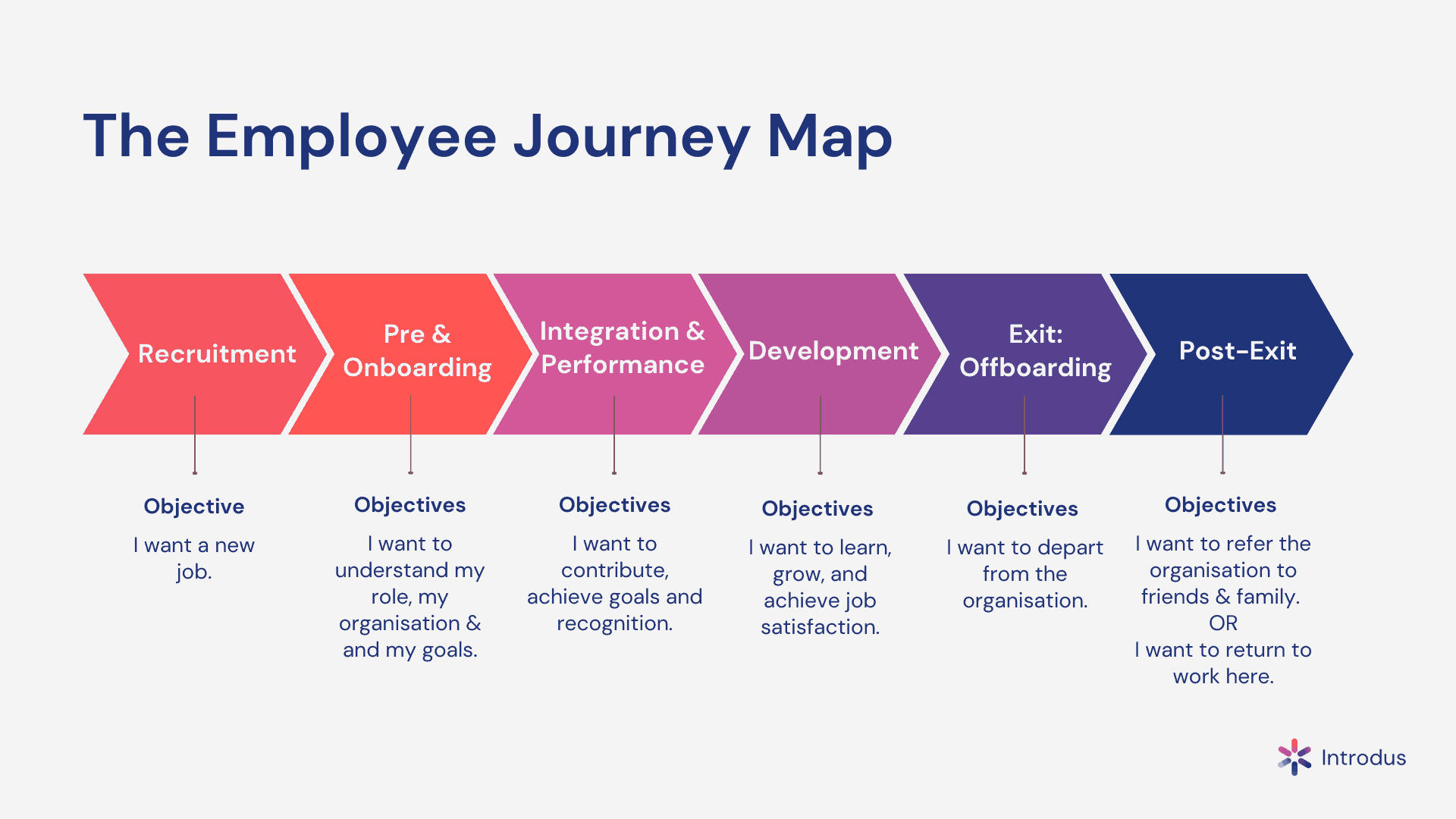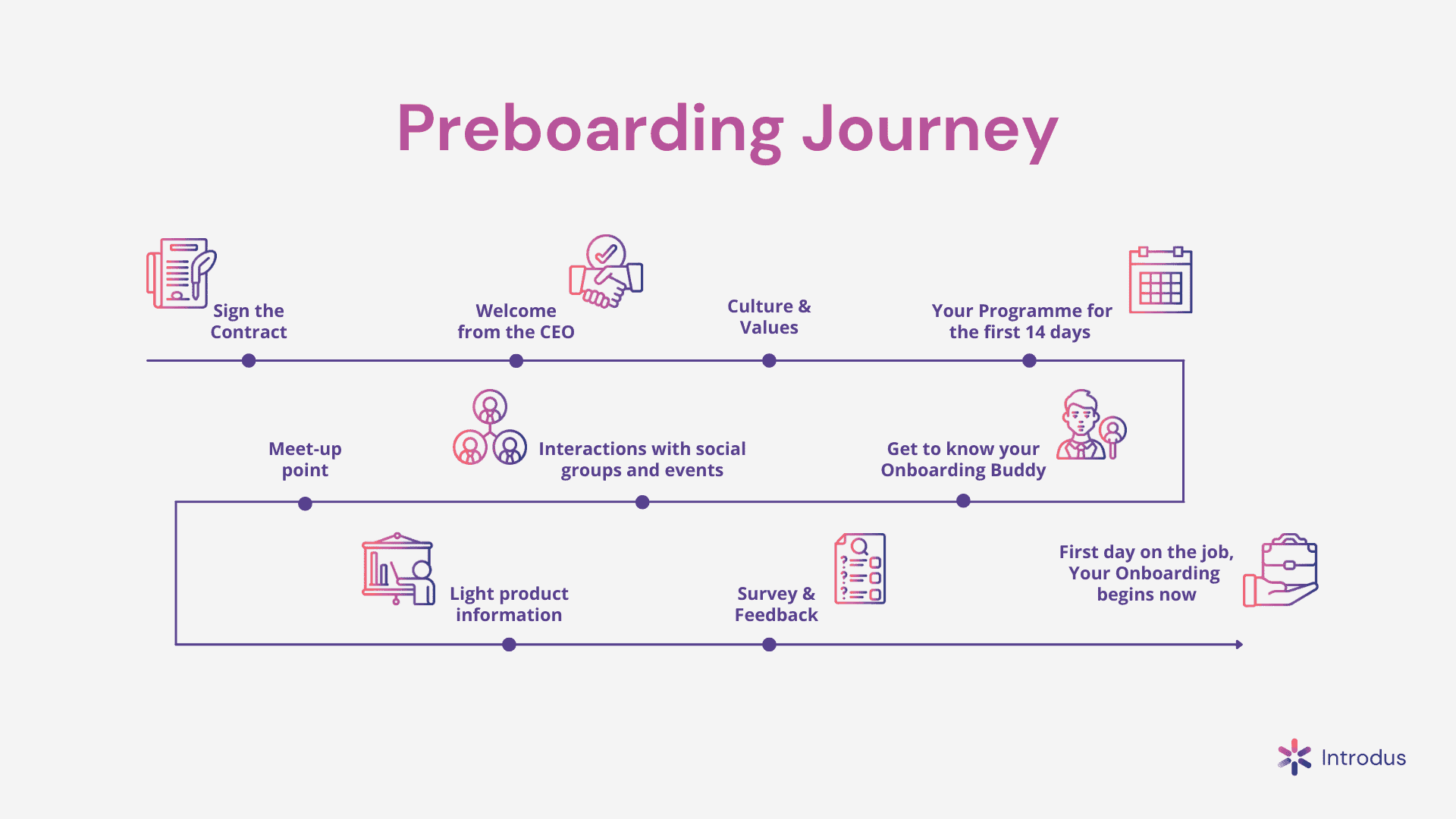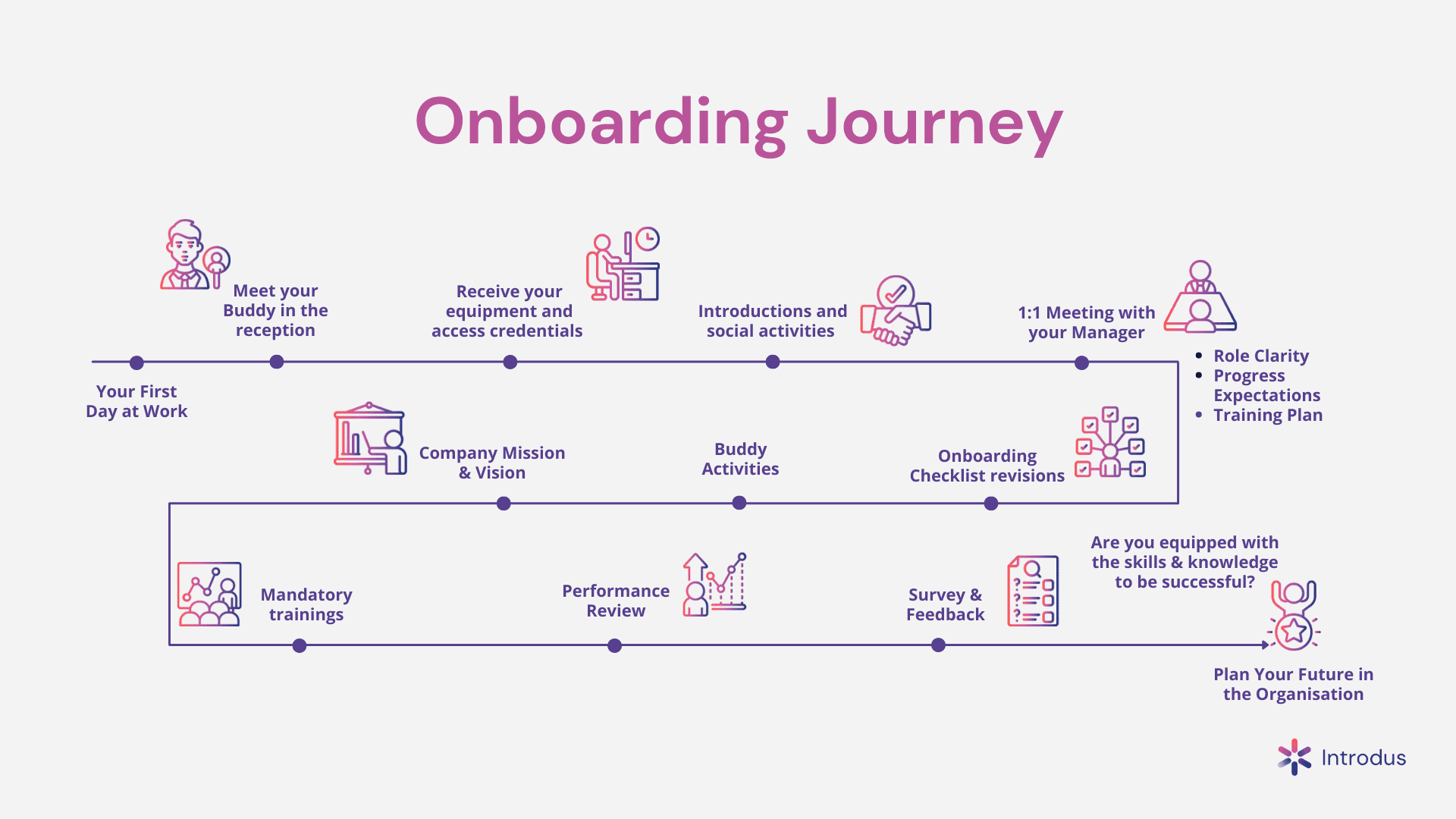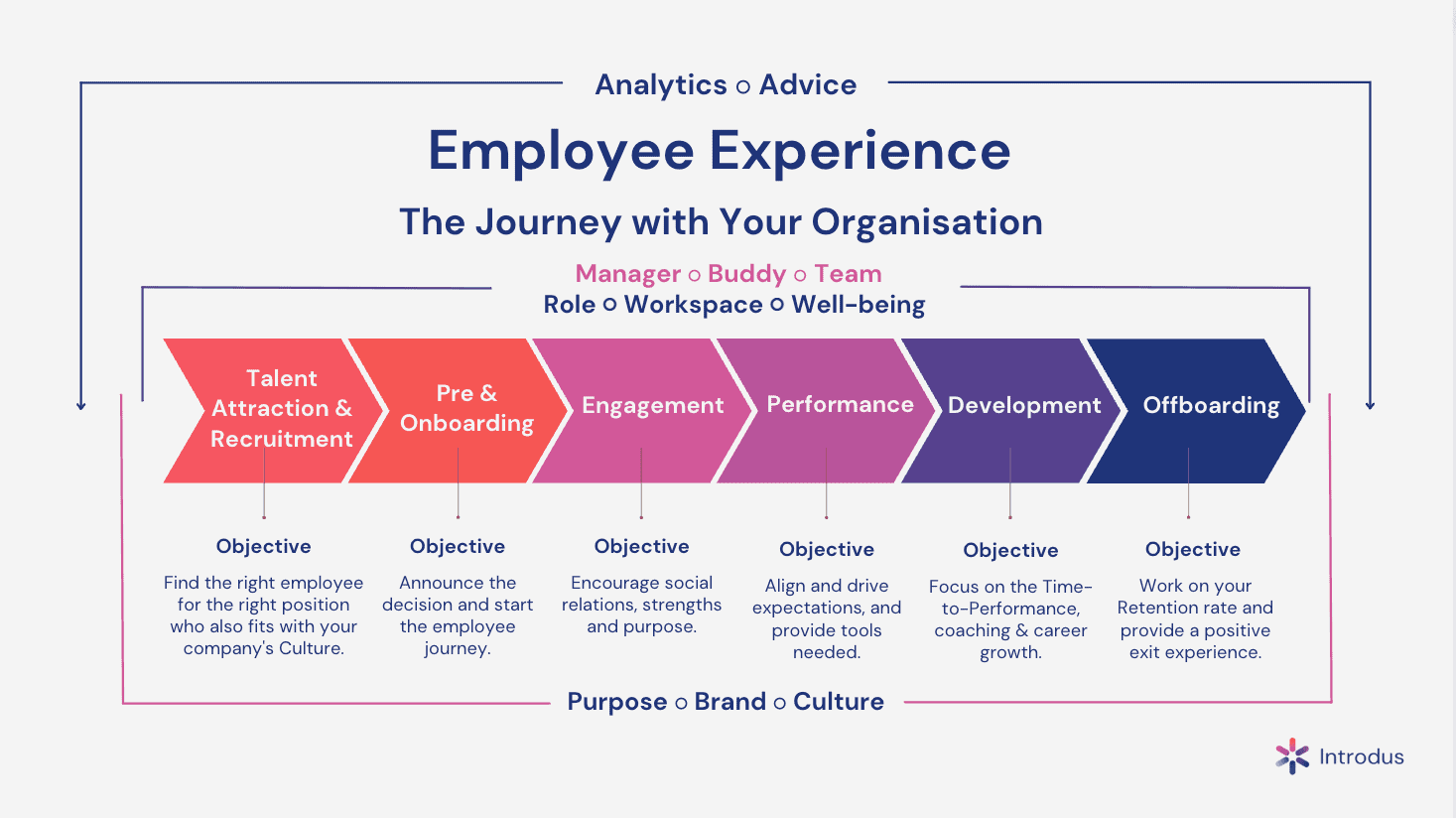Key Moments of The Employee Journey Map: Template
An employee journey map portrays your employees’ experiences at every phase of their tenure with a company. They can view the journey map as a storytelling tool across the various stages of the employee lifecycle. Employers should make every experience better and portray expectations from the very beginning of the journey.
We have drafted an employee journey map template. You can download our free employee journey map template right here:
What is the Employee Journey Map?
The employee journey map is a visual representation of employees’ interactions with their employer throughout all the stages of the employee lifecycle. Employee journey mapping helps businesses step into their employee’s shoes. They do so in order to acquire an employee experience perspective.
Every employee journey with an organisation starts with the application period and recruitment. It concludes with the exit from the organisation, Offboarding. Preboarding & Onboarding are also critical stages. You can build strong strategies by using an onboarding plan. Yet, even after offboarding, the journey could resume. This is valid in cases of returning to work for a former employer, hence, Reboarding.
There are multiple tools that employers can use to manage their time inside a company. We publish some of these tools on our blog HR. For example, you will find articles on the HR lifecycle and the employee life-cycle model. An employee journey map is a similar tool.
How an Employee Journey Map Can Impact the Employee Experience
An employee journey map is a graphical tool that painstakingly describes the moments that matter to employees. Undoubtedly, employees react emotionally to different moments.
You can maximise the key moments that improve employee engagement and minimise those that result in disengagement. Employees with emotional satisfaction will stay engaged with the job and enhance the productivity of the company.
This is why we created the ‘Moments of Power’ framework. It is essential that the employer acknowledges the most important moments at the start of the employee journey. Check out the moments of power below.
The Four Benefits of Employee Journey Mapping
Pinpointing the employee journey’s important moments helps build a strong foundation for a positive employee experience. Furthermore, a thorough examination of the employee journey will show that each stage presents different challenges and opportunities. This is valid for both employees and employers. Let’s review some key benefits of employee journey mapping.
1. Get Different Stages that Bring Specific Experiences
Let’s take the case that you would like to measure employee engagement. It might be tone-deaf to treat the entire workforce as a single unit with a shared experience. After all, different employees have different experiences and they are many times linked to the stage in their journey. Furthermore, is it not intuitive that a new employee might not share the same experiences as an employee who is about to leave the company?
Thus, employee journey mapping will help differentiate between each stage of the employment relationship. Once the employers define the stages, they can proceed with identifying areas that need intervention.
2. Take the Opportunity for Insights and Anticipation
Employee journey mapping offers valuable insights into the employee journey with an organisation.
For instance, the way new hires start this journey matters. It can set you on a positive work journey with the employer. However, if new employees start on the wrong foot due to errors from the employer side, they might never build the desired engagement and connection with the job. Thus, there is no second chance for making a good first impression.
Other notable essential moments in the journey of an employee are the first one-on-one with the direct manager, or the first full performance review. Moreover, onboarding process activities, training, and team events are also highly relevant. These events shape their experience as an employee in an organisation, minimising their time to performance.
An employee journey mapping exercise helps the employer better prepare for those crucial moments. If having access to training is important to employees then also your journey map will contain this critical stage.
3. Get the Insights for a Better Hiring
Maybe it’s not the most intuitive benefit, but employee journey mapping can also offer an opportunity for better hiring.
Actually, understanding journey mapping can help companies understand the organisational core values. By doing this, they get a better understanding of who will fit well and thrive in the organisation.
This clarity can contribute to attracting and hiring competent and happy candidates compatible with a company’s experience. This enables HR to select the candidates that best suit the company’s operations and that will thrive in the company.
4. Improve Your Employee Engagement
The employees’ experience with an organisation impacts their productivity and the organisation’s success. Positive experiences lead to engagement and longer tenures within a company. The essential moments of the employee journey map should aim to create a memorable experience that can have a lasting impact on employers’ opinion of the workplace.
Moreover, the employee journey provides useful insights on engagement due to the countless feedback from employees. With this, employers will know what motivates and inspires them. Regardless if you work in a small company, or a large enterprise, employee engagement is crucial.
Employee Journey Map Insights
You can maximise the key moments that improve employee engagement and minimise those that result in disengagement.
Best Practices to Create an Employee Journey Map
We have compiled a set of best practices to help create an employee journey map.
Listen and Collaborate
Creating an employee journey map is not a task that a single person can ful-fill with no additional input. Collaboration and listening are key for gathering enough data and insights. After all, the journey map has to portray employee’s needs and perspectives.
However, HR should not assume they know it all, even if they are also employees. Of course their personal experiences are relevant and can be a starting point. But HR also has to encourage feedback from others at various levels and functions. This will ensure having access to multiple perspectives.
Develop Employee Personas
We already discussed that employee experiences vary across the various stages of the journey. The employee personas would be a way of differentiating between the experiences specific to different stages.
Personas are used frequently in the user experience field. The goal is to identify different types of customers, pain points, goals and needs. In our case, the customers are the employees.
So, when doing employee journey mapping it is essential to identify all the key employee personas. Some criteria to differentiate between personal could be personality, demography, and career line, department, and of course, stage of employment.
Thus, some example of employee personas are: the candidate, the onboardee, the integrated employee, the career ladder climber, the departing employee, the returning employee.
Additionally, the onboardee employee persona can be further split into: the manager onboardee, the junior onboardee, the technical onboardee and so on.
Map the Employee Journey
Mapping the employee journey follows right after identifying employee personas. This involves deciding on the key employee lifecycle stages.
For example, we have selected 6 stages: Recruitment, Pre & Onboarding, Integration & Performance, Development, Exit: Offboarding and Post-Exit. A few mentions should be considered about these stages. Buddy Onboarding is a complimentary process to Pre & Onboarding. Moreover, the Development stage could also include a crossboarding process. This occurs when you switch to a completely new role.
Additionally, it is essential to identify what experiences are specific to each stage. In this context, an employee engagement survey can help collect quantitative and qualitative data. The data has to reflect which experiences are specific for each stage.
By starting with a solid foundation, by talking with current employees, by identifying their values, and the steps of your organization’s employee journeys, you can begin to map out what yours will look like, and how to integrate it with your organization. The survey will also identify the specific pain points, goals and needs.
Define Possible Interventions
Data collection has revealed pain points and additional employee needs. After knowing what is working and what is not, the opportunity for interventions and improvements arises.
For instance, a key feature of the employee onboarding journey map is effective communication between the new employees and the current workforce. Hence in the onboarding process, organisations should leverage effective communication properly while bringing new employees on board.

Employee Journey Map Examples
We have developed two employee journey maps. They detail the Preboarding Journey and Onboarding Journey respectively.
If you are curious to read more about preboarding vs. onboarding, we have devoted an entire piece on it.


Employee Journey Map Template
The employee journey map template is a tool that unites the employee experience across the lifecycle. Thereby it provides a holistic view critical to identifying and prioritising areas of focus. Then, the company can identify organisational actions, as well as the elements that will enable employees. This will establish the right impression in them and spur you to build the right engagement with the jobs.
You can download the employee journey map template for free and start your mapping process right away.
The first step for employee journey mapping is evaluating the employees’ experience to identify issues and opportunities to grow. Subsequently, all the information informs the creation of the employee personas. Once the personas are identified, the employee journey map template is an instrument that can easily customise this information.
The Six Essential Elements For the Employee Persona on This Template
Our employee journey map template highlights six essential elements for the employee persona. These are:
- Goals & Needs: What are employees trying to achieve?
- Touch Points: What people, things, or organisations do employees get in contact with?
- Organisation Actions: What does the organisation do at this step?
- Barriers / Pain Points: What barriers come in the way of achieving their goals?
- Enablers: What helps employees achieve goals?
- Desired Impact: What is the desired impact?
Employee Journey Map Template: A Concrete Example
An employee experience journey mapping template is a tool that an organisation can use to showcase the worker’s entire journey in its establishment. It is an easy-to-use tool that can be edited and shared easily with the relevant stakeholders.
Let us take a concrete example using the candidate persona.The candidate persona seeks employment in a new organisation.
The touch points are: the application portal, the company’s social media accounts, recruiters, job boards, etc.
The organisation actions are: reviewing the application and if relevant inviting the candidate to an interview. The organisation will have to ensure that the applicant matches the role and the organisation as a whole. Additionally, the recruiter would make him/herself available to the candidate in case of questions regarding the application process.
Some barriers for the candidate persona would be: insufficient information regarding the application, unresponsiveness from the recruiter, misleading information regarding the role, negative reviews of the employer.
Some examples of enables are: friends or family already working in the company and referring the candidate, a very responsive recruiter that provides comprehensive answers to any curiosities & questions.
The desired impact for the candidate persona is receiving an employment offer and signing a contract.
This is a general and simplified example. It can be further customised. For example, designing a journey for a senior level candidate and an entry level candidate. Or for example, for a sales candidate or a business development candidate etc.
Employee Journey Map
Globally, only 20% of employees declare themselves as being engaged at work.
—Gallup.
Employee Experience Journey Map
An employee experience journey map helps track the key stages and experiences in the employee journey. It creates a chronological chart that visually captures and examines each step of the employee experience. Although prevention is better than cure, business organisations should aim to improve the employee experience and not wait until issues spring up.
When employees have a positive experience, it translates into increased engagement, greater productivity, reduced recruiting cost, and low employee turnover.
The employee experience journey map of an organisation offers a unique way of representing the company’s goals, values, and processes. Again, it helps bring the company’s core values to life and build a strong culture.
Globally, only 20% of employees declare themselves as being engaged at work, according to Gallup. Thus, the vast majority of employees worldwide are having unpleasant work experiences and very little connection to their employing organisation.

Don’t Overlook Employee Mapping: Concluding Remarks
No doubt, the major challenge confronting most business organisations is getting their employees to feel engaged with their work. This is additionally coupled with a need to achieve better work efficiency.
However, the employees could have some underlying experiences hindering their capacities to perform optimally. This is why employee mapping is a useful tool for gauging the experiences of the workforce of an organisation.
Employee mapping starts when you gather everyone involved in the process of an organisation. Besides, it defines every step in executing the process. This helps in achieving rule compliance, business process improvement. Additionally, it helps boost employee effectiveness.
Hence organisations should leverage the right employee onboarding solutions tools like Introdus, employee onboarding software to bring onboard the new employees. Due to onboarding automation, new employees have access to a platform that ensures social integration with their employers from day 1.
Also, it has useful multimedia content that will empower new employees and build the right engagement with their jobs.
In conclusion, an employee journey map is a great asset in achieving employee engagement if properly harnessed. In addition, it will aid organisations in building their workforce with the right morale and motivation, thus resulting in enhanced productivity and profitability.
Remember that you can also check a Return Work Plan, by clicking here.